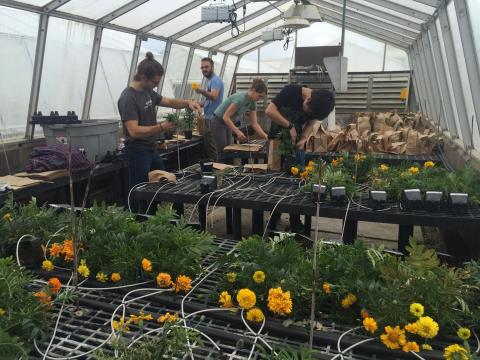Science may have the solution. Similar to charcoal, biochar is produced through a process called pyrolysis, or heating to high temperatures in the absence of oxygen. And like charcoal, it can be derived from virtually any organic substance. To save the peat moss, we have to burn some other stuff. But even then burning is better for emissions than runaway peat moss exploitation by the organic community.
Peat bogs naturally store carbon. When peat moss is harvested, there's a transfer of a global carbon sink into a net source. Unlike organic material, biochar decomposes very slowly - potentially on the order of centuries - so when organic material is turned into biochar, the carbon is essentially sequestered and can't escape back into the atmosphere.

Image credit: Andrew Margenot
But how well does it work in potting mix? To find out, a team grew marigolds from seed to flower in a number of experimental potting mixtures that replaced peat moss with an increasing proportion of commercially available softwood biochar. In the biochar mixtures, pH soared. "The ones with lots of biochar had a pH up to 10.9, which is ridiculous for trying to grow things," says Andrew Margenot, assistant professor in the Department of Crop Sciences at University of Illinois. But this wasn't unexpected for the type of biochar the researchers used.
Marigolds grew and flowered just fine, even when biochar replaced all of the peat moss in the potting mix. However, for plants growing with high concentrations of biochar, the early stages were a struggle.
"You could see that the plants took a hit in the early stages of growth - the first two to three weeks. They were shorter and had less chlorophyll, indicative of a nitrogen deficiency, which you'd expect at such a high pH. But these plants caught up by the end. By flowering stage, there was no negative effect of biochar versus peat moss," Margenot says.
Not only did the plants suffer no long-lasting negative effects of the biochar, the pH in those pots neutralized by the end of the study. Margenot thinks this could have been due to a natural process of ion exchange between plant roots and potting mix, naturally occurring carbonates in the irrigation water, or the use of industry-standard fertigation - irrigation with low levels of dissolved nutrient ions such as nitrate and phosphate - in the experiment.
"In our study, we used one made from softwoods from selective logging. But biochars can be made from corn stover, switchgrass, and lots of other organic waste products," says Margenot. "Biochar could even be made from a greenhouse operation's own waste, if there are trimmings from plants or old peat moss."





Comments